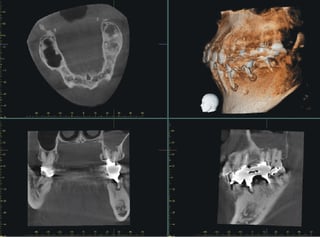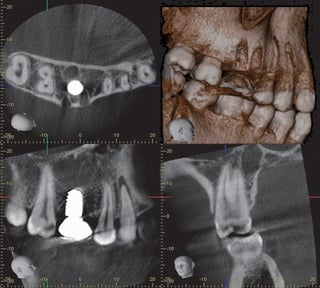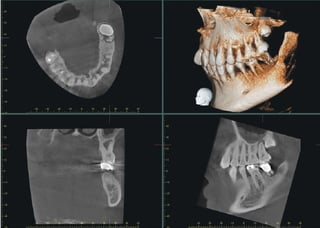Interest in CBCT technology in dental has grown substantially as more general dentists place implants and recognize the value of virtually planning the procedure for the best treatment results. There is no substitution for being able to accurately measure bone level and thickness prior to placing an implant.
Most CBCT software allows for the virtual placement of the implant so that the exact best placement can be determined prior to the actual procedure. The peace of mind that this kind of precision offers helps dentists placing implants avoid sleepless nights wondering about the success of difficult procedures. Buccal perforations and angulation errors become a thing of the past with a properly used CBCT scan.

As CBCT is quickly becoming the standard of care, it is important that we educate patients so they understand it results in the best care and plan for treatment available. One of the issues we anticipate is if CBCT is available, but not utilized, what are the consequences if there is an issue?
Dental TI sells the J. Morita line of CBCT technology. In fact, Dental TI is the first dealer that is authorized to install and train both Morita’s F40 and R100 CBCT units. We recognize the importance of training in insuring that our J. Morita CBCT owners get the most out of their investment in CBCT. So what constitutes a good training program and how do you make sure that it is relevant to your needs? Based on our experience of working with many new CBCT offices, I can offer the following advice.

The first step is working with the company selling you the technology to create an outline that highlights your immediate training needs and future training needs. CBCT technology and the related software has enough facets that it is very difficult for offices to learn everything at once. For example, the J. Morita F40 and R100 comes with i-Dixel 3D software for 3D viewing and treatment planning. The software allows for measurements and virtual placement of implants. However, it does not allow for the creation of surgical stents. Dental TI always includes another software package called BlueSkyBio that does allow for the creation of surgical stents. Most offices that we train learn the basics of i-Dixel prior to learning how to use BlueSky. Many find that learning i-Dixel first makes using BlueSkyBio that much easier. Most offices like to get used to the basics of their new CBCT system prior to jumping into the more advanced offerings. Having a pre-training outline can help create a roadmap for success and phased training. Dental TI offers both in office and remote training. In office training is utilized in teaching the staff the mechanics of the system. Remote training sessions are utilized to help the Dr. learn the software as they progress through the learning curve.

Once you get your CBCT system installed it is important that your staff has the protocol and knowledge to help you get the areas of concern with the best quality and least amount of radiation possible. Dental TI always recommends that you have several scans planned for the on-site training session. Having at least eight live scans scheduled on staff and family members can give the staff the opportunity to truly experience the machine prior to using it on patients. Also, it is very important that an imaging protocol is established so the staff member knows the correct FOV for the procedure that is dictating the scan. For example, the J. Morita R100 has 6 FOVs ranging from a small FOV of 40X40 to a large FOV of 80X100. ALARA dictates using the smallest FOV that is required for the procedure. Having a protocol established for procedures will insure that the correct FOV is used every time. Spending time on positioning fundamentals will help the staff know how to deal with more challenging cases like a patient having high shoulders and a sort neck. The J. Morita R100 and F40 both allow for the radiation to be turned off so rotation can be checked and adjustments made to clear abnormally high shoulders. The staff should simulate this scenario during the training so they are prepared for it with an actual patient.
Finally, it is important that the Dr. know where to go for ongoing training in radiology and has access to ongoing CBCT training from a clinical standpoint. Having a relationship with a radiologist or company that can read CBCT scans for a fee is very important. In particular, when large FOV scans are used that image areas outside of the dentition. Remember that if you took the scan you are responsible for reading the entire scan and not just the area that you are focused for the proposed treatment. When in doubt pay the $50-$75 fee to have a radiology report. Also, consider on going courses that may be offered by the manufacturer of your CBCT. For example, J. Morita offers ongoing educational courses for its users that are taught by Dr Bruno De Azevedo D.D.S., M.S. who is a radiologist and dentist. He is also an associate professor at the University of Louisville. He has been using J. Morita’s imaging technology since 2001. He also uses an R100 at the University of Louisville daily. Ongoing clinical training by a dentist who uses the technology that you own is invaluable.
In conclusion, CBCT technology can be an invaluable tool with the proper protocol for use and training to accompany that protocol. By having a plan for training and implementation you will find that your practice benefits more quickly and fully from the investment. Please feel free to call Dental TI at 800-672-5733 to discuss CBCT implementation and training.





Leave Comment